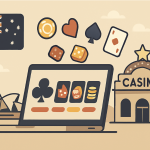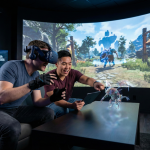Wouldn’t it be cool if you could read meaning into all this movement that might help you place a missing queen or decide if someone is bluffing? Here are five Body language signals you can learn to help you win at cards.
How to Read Your Opponents

5 Body language signals you can learn to help you win at cards
Many people play their favourite games online these days. Online bridge, which was begun by OK Bridge over 20 years ago, has become very popular. It’s accessible and convenient. You can play in the luxury of your home with friends, partners, teachers or experts worldwide. View our Play Bridge Online page to see all the offerings for online bridge today. Online casinos have also grown for similar reasons. Playing your favourite card games while sitting in your living room has its appeal. For one thing, you can play in your sloppies and no one will know!
However, online gaming will never replace the excitement and challenge of sitting down at a real table face to face with living opponents. And one of the biggest differences is what is known as ‘body language’.
Body language is a kind of nonverbal communication, where thoughts, intentions, or feelings are expressed by physical behaviors, such as facial expressions, body posture, gestures, eye movement, touch and the use of space. Source: Wikipedia.
Place yourself at the bridge table (or poker, or any other skill-intensive game) and you immediately get a feel for the ‘bodies’ around you. The feet shuffling, the knee bobbing, the tidying or doodling. Wouldn’t it be cool if you could read meaning into all this movement that might help you place a missing queen or decide if someone is bluffing?
Below are 5 Body Language Signals that will help you read your opponents’ true feelings and intentions.
1. The eyes
If a player is making frequent and/or intense eye contact, it may seem like an intimidation tactic, but actually reveals insecurity. If the player’s staring is punctuated by frequent glances at their hand, it could mean that they are planning a big move and they’re checking to see how other players at the table might influence its success.
If the player is right-handed, and most people are, looking to the left most often indicates a lie, a bluff, or some kind of made up story. Conversely, looking to the right implies truth.
2. Fidgeting
A bouncing knee, frequently shifting in one’s chair, tapping the table, playing with their hair, or other small, repetitive movements can show a player subconsciously expressing impatience. A player who is experiencing anticipation anxiety over an upcoming move will become impatient, wanting to just get it over with. A player who is confident in his hand or in his plan will stay relaxed and relatively motionless. Be careful though when trying to interpret fidgeting. It could simply mean the player is nervous or under stress for reasons that have nothing to do with their game. Combine fidgeting with other signals to get a more accurate understanding.
3. Barricades and barriers
Crossing arms or placing objects between themselves and their opponents are ways a player can create ‘barriers’ between themselves and something they perceive to be undesirable. Commonly, a player will rest their crossed arms on the table in front of them. In poker, they may stack and restack their chips to make a kind of wall. If they are drinking, they may move the cup in front of them, and keep their hand on it, making a barricade out of their arm. Other ‘crossed arms’ gestures could be fiddling with a cufflink or bracelet, holding a sweater closed, massaging ones on shoulder. Most people display this kind of body language when they are among strangers – at the card table you might see it happen suddenly mid hand or during the bidding – this is when you can assume it has something to do with the opponent’s cards or maybe his partner’s bidding.
4. Hands
A lot of typical body language is restricted when a player is holding cards. Watch to see if they place their cards in one hand, or on the table, in order to use the other to fidget or fiddle. If they tidy, they are trying to regain control of something they feel has gone sideways. If they are holding things on the table, like a coffee cup, or a pen, these are being used as comfort objects. However if they grab their coffee cup, or pencil or scorecard, suddenly, this could show they feel a need to hold on to something, as if unstable or falling.
Clasping and squeezing hands together is a self-pacifying gesture. Clasped hands with interwoven fingers indicate great anxiety and frustration. That person is thinking, “Things are going really bad”.
Because hands are often used in communication, hiding the hands could mean the person doesn’t want to collaborate or doesn’t agree with their partner or what’s going on at the table. They might hide their hands under the table, or in their pockets, or simply place them palms down on the table. Liars or bluffers might hide their hands in order not to give their bluff away.
5. Confidence
A confident player’s body language is exactly the opposite of an insecure player’s. Confident players may rest their ankle on their knee or use an arm to support their head as they lean back in their chair. Any type of ‘open’ pose could indicate a degree of confidence. Open poses include using armrests, resting feet on another chair, or sitting with legs spread wide. Additionally, the player’s face will appear relaxed or expressionless. A confident player is more likely to watch and keep track of what’s going on in the game, as they are not as occupied with planning their own moves or gauging the behaviour other players. If you suspect someone is unusually confident, act distracted before asking whose turn it is. The confident player will be the first to answer because they’ve had the luxury of paying attention to things rather than being distracted by their own plans, cards, or problems.
These are just a few body language indicators. If you want to learn more, there are many great websites that discuss body language in general. Psychology Today, for example, has quite a comprehensive collection of articles.
A Word of Warning
It might occur to you that you can ‘fake’ body signals and thus mislead your opponents. That missing Queen for example. What if you have it but ‘pretend’ to not have it with body language? This can sometimes work but there is an important factor you will want to remember: faking your body language can actually change your mood.
You can try this out – when you’re sad, force yourself to smile for a while. Gradually, you will start to feel happier. In contrast, when you try to fake anxiety by fidgeting, glancing around sporadically, swallowing or blinking a lot, and appearing uncomfortable, you may actually start to feel anxious or stressed as a consequence. These feelings can throw you off your game and make it harder to think clearly.
Some players have developed habits that hide their body language. You’ve all met the player that constantly bobs their knee or who is always rearranging their cards. I once kibitzed a high-level team match and the player I was watching sorted his cards constantly throughout the bidding. Into suits, reverse the suits, high to low, low to high. This was a very experienced and successful player – obviously this sorting had developed over time and helped him focus. Some players might stroke their beards which actually hides the tiny muscles around their mouth that might give away a bluff.
Psychologist Paul Ekman, a pioneer in body-language science, described body-language as being universal to all humans, regardless of race, culture, location, or any other categorical variable. If you’re a poker player you might find Dr Ekman’s books, and courses, very interesting and useful, especially his teachings on bluffing.
Good luck and have fun!
Play at Casino NETBET (netbet.co.uk) and access the very best online casino games and start playing in demo mode straight away to practice or play in real mode to win big. Learn the game online before sitting down at an old fashioned match at the green tables.








